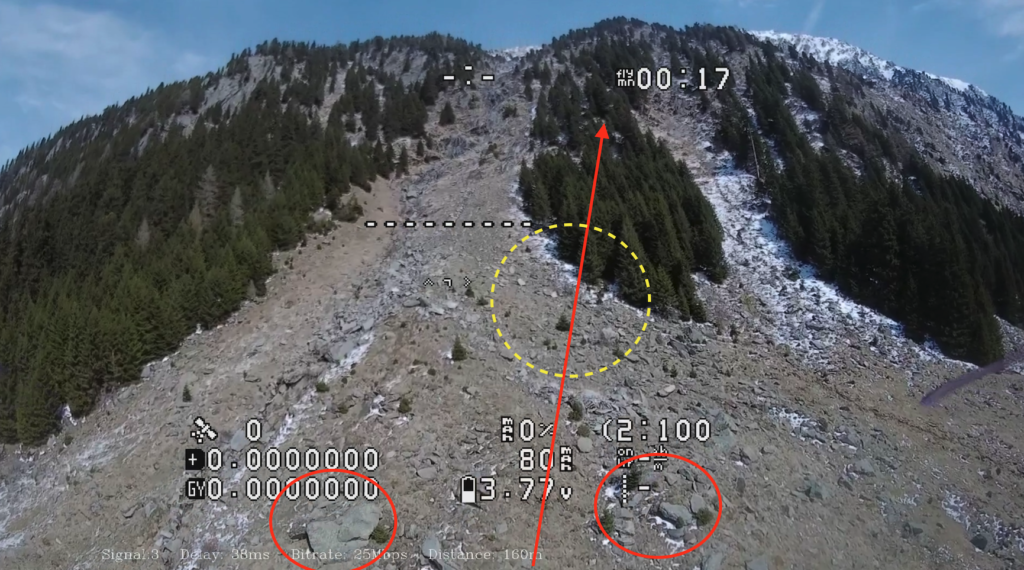
Back in April 2023 I lost my Megabat drone. One moment it was flying, and the next, the headset display lost connection. Six months later, I found it after diagnosing the last moments of footage and performing a grid search in the location I thought it came down.
Loss
Here is the last still from the flight.

And then the image that strikes fear into any FPV flier:

Normally after this happens:
- The person with you spotted where it came down. No, that didn’t happen this time
- You can find the approximate last location from the GPS. No, fail – I decided to fly despite the GPS not initializing prior to take-off
- The buzzer alerts the location. No, suspiciously silent
- Looking around yields something. No, nothing obvious, and not a great idea walking around on a scree slope during snowmelt time
From the ground, this is the scree slope where it came down:

So, MIA.
Analysis
Post-loss, I was pretty certain it had flown into the trees, and was a massive write-off, as when the display went blank I throttled the drone high up to see if I could recover broken video signal, then pushing it into a crazy flight path. However, a further near run-in with a different drone made me rethink this. Basically, what if it had lost complete power? This could answer the question as to why the buzzer didn’t work, and that the video signal just went completely blank.
With this in mind, I reviewed the last moments video and established the approximate direction. I could guess the distance from the last video position by using a projectile motion calculator. This would narrow my search considerably. Therefore, I considered:
- Approx speed at loss: 50 km/h = 13 m/s
- Approx height at loss: 30 m
- This comes out at about 36 m of unpowered falling!
I plotted this on the image of the last flight, with the red arrow indicating direction, the two circles indicating good points of reference for my grid search, and the yellow-dotted circle showing the search zone based on the unpowered fall:

Now time to go hunting.
Recovery
Back on location, in the summer, and time to do the grid search! I used the tree point of references, and inspected around the rocks and in crevices for a drone.

I found it pretty much in the centre of the search area, heavily embedded in the rocks and grass:



Salvage
Post recovery, after a drone sitting in the elements for six months, I found the only elements that can be reliably be reused are:
- The GoPro
- The frame (albeit discoloured)
- The antennas
As for everything else:
- The props were damaged in the crash landing
- The motors are rusted up, with the bearings grinding on turning. They may fly again after a heavy soaking in WD40, but never in a drone that I would fully trust
- The FC and RX Crossfire module still work! Again, would I trust these in a drone?
- The ESC was fried, but I suspect that was the reason for the drone failing
- The Avatar VTX doesn’t work
- The LIPO – I wasn’t even going to try this, irrespective of the corroded positive pin!
- Screws & bolts – all with surface rust
Really, the GoPro recovery is the biggest win.
Conclusions
Here are the things I draw from this:
- Don’t fly a sick drone. Yes … so tempting … the GPS zero’d and other sporadic flickers indicated something was not quite right with the power, but I flew “just one more battery”. Really, if something is up with the drone, give up the flight!
- Use a powered buzzer! Best investment ever! A buzzer really helps to pinpoint where the drone is, but it is no use if the main battery power is lost. I now fly with a VIFLY GPS Mate, which doubles as a buzzer and a fast GPS sync
- Have reliable GPS signal – it will pinpoint the last communicated position and give a good idea where to begin the search
- Record headset footage, so at least you can analyse the last moments and figure out where the drone might have been lost. If the person you’re with spots it going down, that helps massively as well
- Use flight data to find the drone. Yes, obviously, but you need to have it, and the more you have, the better.
- Exposure to elements is not kind to drones. Time to find is pretty important. If you leave a drone out in the open for too long, not much is salvageable. Start the hunt as soon as possible
Despite the long laundry list of failed items, the operational GoPro recovers half the cost of the drone, and it was awesome to bring home a much-endeared drone.